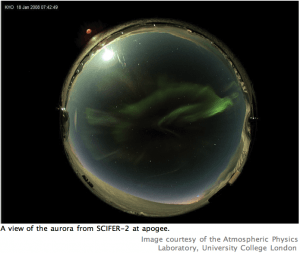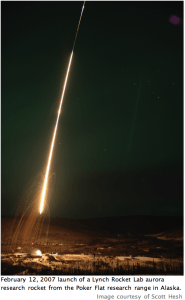Last December, Dartmouth professor Robyn Millan received exciting news from NASA: she and her team were to receive a 9.3 million dollar research grant to finance a proposed plasma physics project in Antarctica. Interestingly, Millan’s fascinating new project is not the only experimental plasma physics research being conducted by Dartmouth professors. Big Green professors James LaBelle and Kristina Lynch are also undertaking exciting research projects of their own in this field.
What Is Plasma?
A typical person’s day-to-day involvement with plasma, the state of matter consisting of superheated, ionized gas, is very limited. The flames from the kitchen stove are probably the closest one gets to plasma. Lightning is another easily recognizable plasma, as is the brilliantly luminous gas that follows the touch of a finger in a toy plasma globe. Yet 99 percent of all the visible matter in the universe exists in the form of plasma. From stars to nebulae to the neon sign in front of a favorite sports bar, plasma is everywhere.
The professors who study plasma physics here at Dartmouth are divided into two groups: the theorists and the experimentalists. Both study the plasmas in the Earth’s upper atmosphere, which are responsible for the aurora borealis and aurora australis, and the teams sometimes collaborate on joint projects. The theoretical physicists use computers to create models of space weather and then test their models through observation, while the experimental physicists conduct experiments first and then create models based on their data.
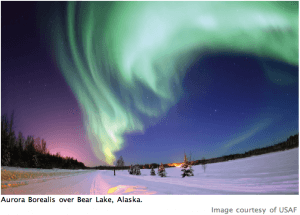 Professor James LaBelle Explains the Aurora
Professor James LaBelle Explains the Aurora
You have probably heard a very simple explanation of why we have auroras. Many science textbooks and articles explain that auroras are caused by electrons emitted by the sun. These electrons are then guided into the polar regions by the Earth’s magnetic field. Once these high-energy electrons hit the atmosphere, they drastically decelerate and give off energy in the form of visible light, which we see as the aurora. According to Dartmouth Professor James LaBelle, this explanation is false. Although this process does happen on a small scale, he says, the electrons that travel directly from the sun to the Earth do not have enough energy to explain the vast displays of dancing lights that make up the aurora. In reality, the formation of the aurora is more complex and hinges on the sun’s solar wind and the Earth’s atmosphere and magnetic field.
Here’s how it works: the solar wind originates in the corona – the atmosphere of the Sun. It is made up of ionized gas much hotter than the surface of the Sun. Some of the higher speed particles in the corona escape from the Sun’s gravitational pull and fly out circumferentially into space. Most of the particles that approach Earth are deflected by its magnetic field, but some manage to enter its atmosphere. The Sun’s ultraviolet radiation is very strong there, and it rips the ions into their positive and negative components, creating what is known as the ionosphere. These free electrons flow in currents around the ionosphere created by the Earth’s magnetic field. Some of these currents enter the Earth’s atmosphere at the poles, while others flow in the opposite direction. Because there are more electrons leaving the atmosphere than reentering it, the particles flowing downward have a much higher velocity than those flying out. When these incoming, highly-energized electrons hit the atmosphere, they excite neutral atoms like oxygen and nitrogen. These atoms release light as they lose this energy, which we see as the auroras. This process serves as a base for plasma physics research at Dartmouth.
Professor Robyn Millan
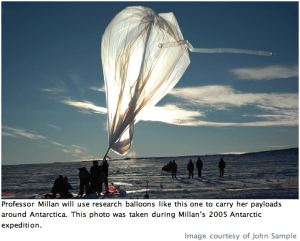 On November 1, 2007, a panel of NASA experts visited Dartmouth to review Professor Robyn Millan’s proposal for her latest plasma physics project, known as the Balloon Array for RBSP Relativistic Electron Losses, or BARREL for short. The goal of the project is to measure the precipitation of electrons from the Earth’s Van Allen belts. These radiation belts comprise a region beyond Earth’s upper atmosphere in which high-energy particles are trapped due to the Earth’s magnetic field. Sometimes these particles escape from the belts and scatter into the atmosphere below. However, little is understood about when and why this process occurs. Millan’s team hopes to find the answers to these questions using a set of balloons. While the particles that precipitate from the radiation belt never reach or even come close to the Earth’s surface, the X-rays they radiate penetrate deeper into the atmosphere. Millan has designed high altitude balloons, each carrying a 40-pound payload, which measure these X-rays to uncover information about the falling particles.
On November 1, 2007, a panel of NASA experts visited Dartmouth to review Professor Robyn Millan’s proposal for her latest plasma physics project, known as the Balloon Array for RBSP Relativistic Electron Losses, or BARREL for short. The goal of the project is to measure the precipitation of electrons from the Earth’s Van Allen belts. These radiation belts comprise a region beyond Earth’s upper atmosphere in which high-energy particles are trapped due to the Earth’s magnetic field. Sometimes these particles escape from the belts and scatter into the atmosphere below. However, little is understood about when and why this process occurs. Millan’s team hopes to find the answers to these questions using a set of balloons. While the particles that precipitate from the radiation belt never reach or even come close to the Earth’s surface, the X-rays they radiate penetrate deeper into the atmosphere. Millan has designed high altitude balloons, each carrying a 40-pound payload, which measure these X-rays to uncover information about the falling particles.
Millan’s unique selling point for the NASA grant is that her BARREL platform works in conjunction with two Radiation Belt Storm Probes (RBSP) satellites built by NASA that, once launched, will sit on Earth’s equatorial plane. These satellites will analyze the particles inside the radiation belts while Millan’s balloons concurrently measure the particles scattered into the atmosphere. The BARREL probes will obtain particularly valuable results when they are in contact with the same magnetic field lines as the satellites in what is known as the satellites’ “footprints.” During these unique times, both the RBSP probes and Millan’s balloons will study the same particles.
The project consists of two separate balloon campaigns launching in December 2012 and 2013, each comprised of 20 balloons launched every one or two days for a duration of one to two months. Prior to this, the team will launch a development campaign in Antarctica and test two prototype balloons to ensure that the payloads are constructed correctly and that the project is properly organized.
The process of applying for and receiving NASA grant money is rather lengthy. Millan and her team submitted their first research proposal to NASA in November 2005. NASA selected the project for a yearlong review process. As part of this review, Millan’s team submitted a written report to the evaluating committee last September, outlining the project and what it hoped to accomplish. Because NASA representatives found the science to be relevant, unique, and useful, they decided to investigate further on-site at Dartmouth. One week prior, the panel sent out 21 questions for which Millan’s team was to provide detailed answers. Three of those questions had to be answered four days prior to the actual visit, which placed quite a bit of stress on the team. NASA’s questions centered around two major concerns: the team’s chance of success and whether the project was cost-efficient. To answer the questions as directly and in as much detail as possible, the team’s presentation specified the technological and organizational project components in excruciating detail. They even noted which team members would have keys to the computer rooms.
Although this was her first site visit and her team was small compared to the other universities’ teams, Millan was pleased with her team’s performance, even before NASA announced it would finance the project. The team had slaved over NASA’s questions and addressed all expressed concerns in the presentation. Millan sometimes helped her teammates answer the panel’s questions when they appeared unsure of what a panel member was asking or when she had vital information to add. “I hate to say it, but even in science there’s a lot of politics. You have to be careful how you answer their questions,” she commented, and added that after 3:00 pm that day, her team had no more opportunities to answer any lingering questions, so it was important that the team offer the panelists as much information as they could during the short visit.
One of the most exciting components of the project, Professor Millan reports, is the integral collaboration between undergraduate and graduate students. Much of the instrument payloads will be constructed in a lab by Dartmouth undergraduates involved in the research and by students at the co-institutions participating in the project: U.C. Berkeley, U.C. Santa Cruz, and the University of Washington.
Millan’s important new project might still be in the developmental stages, but it is not the only the upper atmospheric research happening on campus right now. Two other experimental professors, James LaBelle and Kristina Lynch, are both working on projects that will shed light on the dynamics of the aurora.
Professor LaBelle uses a two-pronged approach in his study of plasma physics: he fires rockets into the ionosphere and maintains an impressive array of ground-based instrumentation in the polar regions. His research is drawn from analysis of the radio waves emitted from the aurora. “I’m kind of a wave specialist,” he claims.
To collect data as part of his ground-based research, LaBelle maintains radio receivers across Alaska, Canada, Norway, and Antarctica. When high-energy electrons bombard the atmosphere to create the auroras, they emit waves from across the electromagnetic radiation spectrum, not just visible light. These waves become trapped in the ionosphere and can be modified by interactions with other waves and particles before escaping and hitting the Earth’s surface. Labelle studies the emitted radio waves, which are around the frequency of AM radio broadcasts. The prestigious periodical Geophysical Research Letters has published several of Labelle’s works on his ground-based experiments. “It’s like getting your picture on the cover of the Rolling Stone,” he joked.
LaBelle also uses his rockets to study waves. “The beauty of the rocket,” raved LaBelle, “is that it takes the receiver right into the aurora where the stuff is happening. On a rocket, you can measure different kinds of waves.” When his rockets reach the ionosphere, they are exposed to radio waves, X-rays, and even sound waves. Many of the standing waves up there are trapped and never reach the Earth’s surface, so they can only be analyzed using rockets. “You could say it’s a wave specialist’s paradise,” said LaBelle. But while rockets can collect valuable data, they don’t fly for very long; LaBelle gets only around 10 minutes’ worth of data from his rockets every few years, which is why his ground-based receivers, which collect data 24 hours a day, are so vital to his research.
LaBelle just launched a rocket in December 2007 from Norway, which was designed to examine the frequencies of plasma gyrations in the cusp of the Earth’s magnetic field. Because plasma is made up of both positive and negative components, these ions create waves by constantly attracting and repelling each other. LaBelle plans to measure the frequency of this plasma gyration to calculate the density of plasma.
The cusp of the Earth’s magnetic field is located directly above each pole, where the field lines get close together as they approach Earth’s surface. Here, says LaBelle, some of the electrons that ride from the Sun to the Earth on the solar wind can actually create a small amount of aurora (just like your old science textbook told you), which will have some effect on the plasma in this region.
Dartmouth has yet another active plasma researcher. Professor Kristina Lynch operates the Lynch Rocket Lab at Dartmouth. The primary goal of her experiments is to measure particle distributions in the ionosphere.
Commencing a rocket project is a long and lengthy process. Professor Lynch and her students build the instrumentation they need to carry out their projects, but the rockets that hitch these devices are NASA-built. Receiving funding for the project and securing a spot on a NASA rocket, Lynch says, is a very competitive process, as NASA only funds about one in every three to four projects.
Lynch has found a solution to this problem. She and her students built a bulky silver machine, affectionately known as “The Elephant,” which can simulate the ionosphere environment on Earth. She creates plasma by exciting argon gas with microwaves, which resonate in the chamber and heat the argon gas.
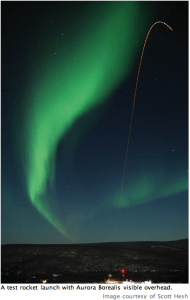 Lynch recently launched a rocket in Norway in January of this year. In this project, named SCIFER-2 (Sounding of the Cusp Ion Fountain Energization Region-2), Lynch measured ion drifts and distribution functions, electron temperature and density, and electron and ion precipitation in hopes of identifying the physical mechanisms responsible for ion outflows in the polar cusp. Only two of the rocket’s four detectors functioned properly during flight, but Lynch collected valuable data that will be analyzed in the coming months.
Lynch recently launched a rocket in Norway in January of this year. In this project, named SCIFER-2 (Sounding of the Cusp Ion Fountain Energization Region-2), Lynch measured ion drifts and distribution functions, electron temperature and density, and electron and ion precipitation in hopes of identifying the physical mechanisms responsible for ion outflows in the polar cusp. Only two of the rocket’s four detectors functioned properly during flight, but Lynch collected valuable data that will be analyzed in the coming months.
Her next project, CASCADES-2 (The Changing Aurora: In Situ and Camera Analysis of Dynamic Electron Precipitation Structures), is a direct copy of the original CASCADES mission. The CASCADES rocket was launched in March 2005, but the engine of the NASA rocket failed mid-flight. The instruments aboard the new CASCADES-2 rocket will measure the structure of motion of ions using an array of probes. It is very difficult to distinguish between variations in space versus variations in time with a single probe. Imagine running in a straight line without looking at the ground. If you felt a bump in the road, it would be hard to tell if you stepped on a bump in the road or just felt a small earthquake. Now imagine running with your friends in single file. If they all slip in the same spot on the road, then everyone hit a bump, a change with respect to distance travelled (dy/dx). If everyone slips at the same time, then there was an earthquake, a change with respect to time (dy/dt). The probes aboard the rocket will work in a similar manner. The CASCADES-2 rocket is scheduled to launch in the winter of 2008-2009.
The year 2007 was an exciting year for Dartmouth plasma physics, and the next few years promise to bring a lot more in the way of experimental research, especially considering the multiple rocket and balloon projects being developed, as well as ongoing theoretical research projects. Expect to see electrifying new developments and plenty of opportunities for undergraduate involvement in the future.
